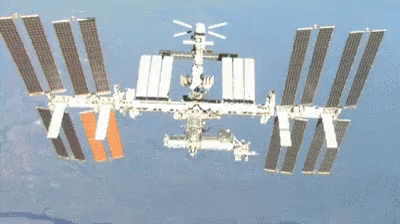ISS - Expedition 66 Mission patch.
Oct. 28, 2021
Four commercial crew astronauts await their launch to join the Expedition 66 crew this weekend as a Russian space cargo mission is on its way to the International Space Station. Meanwhile, the seven station residents orbiting the Earth today are headlong into a series of life science and physics experiments.
The SpaceX Falcon 9 rocket, with the Crew Dragon Endurance attached at top, stands at its launch pad at the Kennedy Space Center in Florida. The SpaceX Crew-3 mission, with its four commercial crew astronauts inside Endurance, will blast off on Sunday at 2:21 a.m. EDT for a 22-hour ride to the orbiting lab.
Image above: The SpaceX Falcon 9 rocket with the Crew Dragon Endurance atop is pictured at its launch pad in Florida during sunset. Image Credits: NASA/Joel Kowsky.
Crew-3 Commander Raja Chari, along with Pilot Thomas Marshburn and Mission Specialists Kayla Barron and Matthias Maurer, will automatically dock inside Endurance to the Harmony module’s forward docking port on Monday at 12:10 a.m. The quartet will then open the hatches at 1:45 a.m., enter the station, and begin a six-month orbital research mission as Expedition 66 flight engineers.
Back in space, the ISS Progress 79 resupply ship, with nearly three tons of food, fuel and supplies packed inside, is racing toward the station after launching Wednesday at 8 p.m. EDT from Kazakhstan. Cosmonauts Pyotr Dubrov and Anton Shkaplerov will be on duty Friday monitoring the Progress 79’s arrival when it automatically docks to the Zvezda service module’s aft port on at 9:34 p.m.
Resupply Ship on the way to Space Station. Image Credit: NASA
The Roscosmos duo practiced and reviewed procedures on a computer in Zvezda for Friday’s Progress 79 arrival. Dubrov also continued his space exercise research while Shkaplerov was back on plasma-dust structures physics research.
While the station awaits the new cargo and crewmates, the orbital residents continued their intense schedule of advanced microgravity research.
Flight Engineers Megan McArthur, Shane Kimbrough and Akihiko Hoshide collected and stowed their blood samples for a pair of human research studies this morning. One long-running study looks at how an astronaut’s body adapts to microgravity before, during and after a space mission. The other observes the cardiovascular health risks of a long-term spaceflight.
International Space Station (ISS). Animation Credit: NASA
Commander Thomas Pesquet and Flight Engineer Mark Vande Hei worked in the Columbus laboratory module on different science maintenance tasks. Pesquet restocked the Human Research Facility with electrodes, needles, and biological sample kits. Vande Hei reinstalled the Light Ions Detector, an advanced radiation detection device, that provides data into the health risk astronauts are exposed to.
Related links:
NASA TV: https://www.nasa.gov/nasalive
Expedition 66: https://www.nasa.gov/mission_pages/station/expeditions/expedition66/index.html
Harmony module: https://www.nasa.gov/mission_pages/station/structure/elements/harmony
Zvezda service module: https://www.nasa.gov/mission_pages/station/structure/elements/zvezda-service-module.html
Space exercise research: https://www.energia.ru/en/iss/researches/human/26.html
Plasma-dust structures: https://www.energia.ru/en/iss/researches/process/02.html
How an astronaut’s body adapts to microgravity: https://www.nasa.gov/mission_pages/station/research/experiments/explorer/Investigation.html?#id=7711
Cardiovascular health risks: https://www.nasa.gov/mission_pages/station/research/experiments/explorer/Investigation.html?#id=7644
Columbus laboratory module: https://www.nasa.gov/mission_pages/station/structure/elements/europe-columbus-laboratory
Human Research Facility: https://www.nasa.gov/mission_pages/station/research/experiments/explorer/Facility.html?#id=67
Light Ions Detector: https://www.nasa.gov/mission_pages/station/research/experiments/explorer/Facility.html?#id=8533
Space Station Research and Technology: https://www.nasa.gov/mission_pages/station/research/overview.html
International Space Station (ISS): https://www.nasa.gov/mission_pages/station/main/index.html
Images (mentioned), Animation (mentioned), Text, Credits: NASA/Mark Garcia.
Greetings, Orbiter.ch




